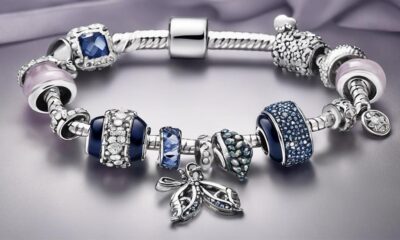Carnival Decoration
What Are the Rules for Bunting the American Flag?
2025
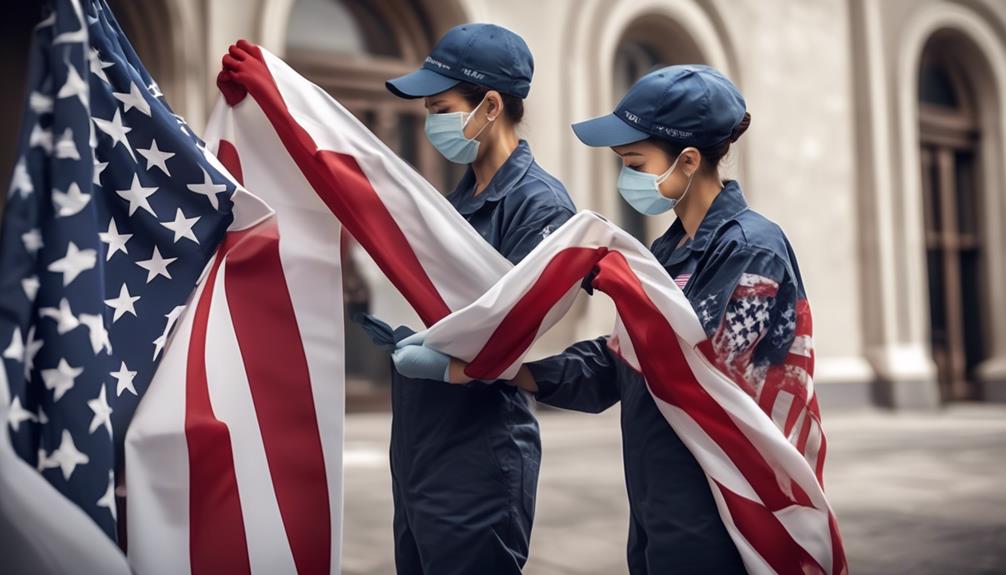
We have all heard the classic saying, “Rules are made to be broken,” but when it comes to displaying the American flag, it is crucial to know and follow the proper rules and guidelines that govern this patriotic tradition.
Whether you're a seasoned flag enthusiast or simply looking to show your support for the red, white, and blue, knowing the proper etiquette for displaying flag bunting is crucial.
So, how exactly should the American flag be bunted? Let's explore the rules and regulations that ensure the respectful and appropriate use of this iconic symbol of freedom and unity.
Key Takeaways
- Bunting has a rich history dating back to the early days of the United States.
- Bunting is used for decoration, honoring historical events, and showing respect for the American flag.
- Bunting should be hung vertically or horizontally with the blue section at the top.
- Bunting should be made from durable, weather-resistant fabric of appropriate weight.
History of American Flag Bunting
Bunting of the American flag has a rich history dating back to the early days of the United States. The manufacturing of bunting, the specific cloth used for flag-making, has evolved significantly over time.
In the past, bunting was made of wool, which was durable but heavy. Nowadays, modern manufacturing techniques have led to the use of nylon and polyester for bunting materials. These materials are lightweight, durable, and have the advantage of being able to withstand various weather conditions, making them ideal for outdoor flag displays.
The process of bunting manufacturing has also become more efficient, allowing for mass production of flags and bunting. This has made it easier for individuals and organizations to procure American flag bunting for various purposes, such as patriotic events, decorations, and ceremonies.
The shift in bunting materials and manufacturing processes hasn't only made flag-making more accessible but has also ensured that the flags are of high quality and can endure for a longer time.
Purpose of Bunting
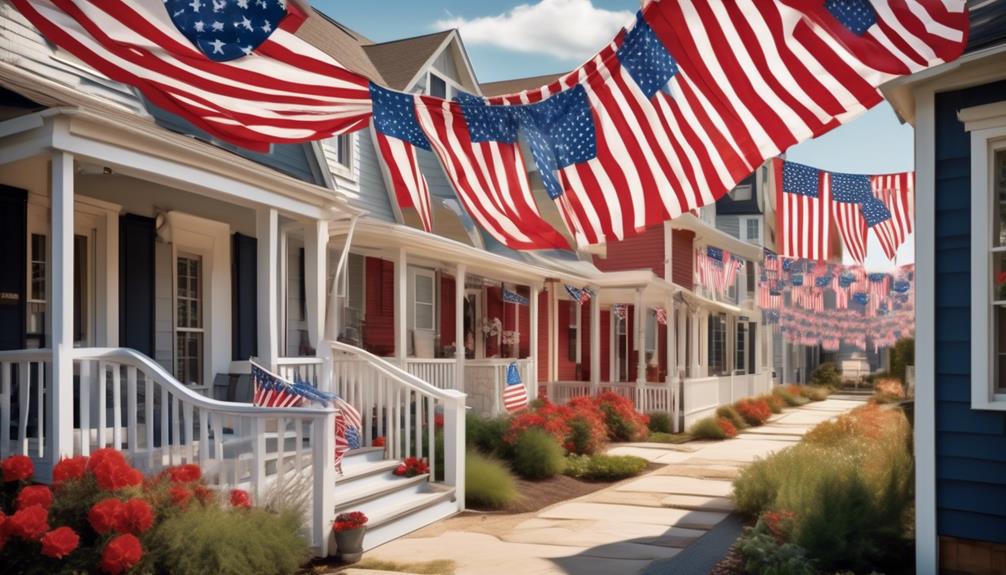
We use bunting to decorate, honor historical events, and show respect for our flag.
Understanding the purpose of bunting allows us to uphold proper display guidelines and maintain the integrity of our national symbol.
Let's explore the significance of bunting and how it contributes to the respectful representation of the American flag.
Bunting for Decoration
When using bunting for decoration, it adds a festive and patriotic touch to any event or space. Bunting material can vary from traditional cotton to durable synthetic fabrics, providing options for both indoor and outdoor use.
Creative designs, such as stars and stripes or thematic patterns, allow for customization to suit specific occasions or themes. Additionally, bunting comes in different sizes and shapes, providing versatility in decorating various areas, from mantels to fences.
Its easy installation and lightweight nature make it a convenient choice for adding visual appeal to celebrations, whether it's for a national holiday, a sports event, or a community gathering.
With the right bunting, any space can be transformed into a vibrant and spirited setting.
Historical Significance
Symbolizing unity and pride, bunting has played a significant role in conveying historical and patriotic messages throughout the nation's history.
The historical significance of bunting lies in its cultural symbolism as a visual representation of national identity and solidarity. From the early days of the American Revolution to modern times, bunting has been used to adorn buildings, stages, and parade routes during significant historical events and national celebrations.
Its vibrant colors evoke a sense of patriotism and pride, serving as a visual reminder of the values and ideals that the American flag represents.
Bunting has been intricately woven into the fabric of American history, symbolizing the unyielding spirit of the nation and the enduring legacy of its people. Its historical significance continues to resonate, making it a timeless symbol of national pride and unity.
Proper Display Guidelines
With its vibrant colors and historical significance, bunting serves as a powerful symbol of national pride and unity, playing a crucial role in conveying patriotic messages throughout American history. Properly displaying bunting is essential to uphold its symbolism and honor the nation it represents.
Here are key guidelines for the proper display of bunting:
- Placement: Bunting should be hung vertically or horizontally with the blue section at the top and the red and white stripes flowing downwards or to the right.
- Maintenance: Regularly inspect and replace worn or faded bunting to ensure it maintains its dignified appearance.
- Respect: When displaying bunting, it should be treated with the same respect as the American flag, ensuring it's never used for decorative purposes or in a disheveled manner.
Following these guidelines ensures that bunting continues to uphold its historical significance and convey the powerful symbolism it embodies.
When to Display Bunting
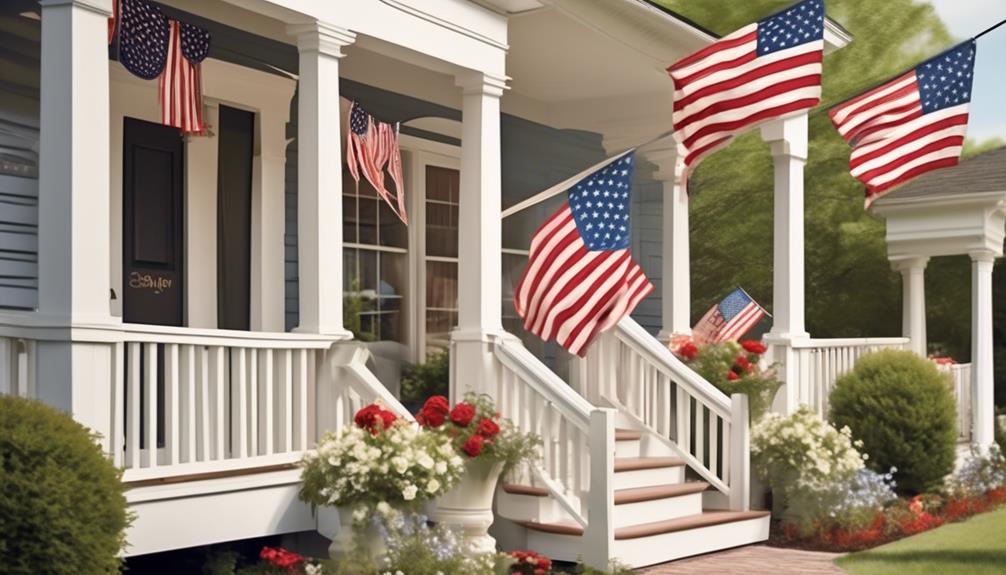
We display bunting on the American flag during patriotic holidays and special events. These occasions include Independence Day, Memorial Day, Veterans Day, and Flag Day.
It's a powerful way to show our pride and respect for our country.
Patriotic Holidays
One of the most common times to display bunting as a symbol of patriotism is during national holidays such as Independence Day and Memorial Day. These holidays hold great significance in American history and are marked by various patriotic decorations, including the display of bunting.
The following are key patriotic holidays when displaying bunting is particularly fitting:
- Independence Day: Celebrated on the 4th of July, this holiday commemorates the adoption of the Declaration of Independence and is marked by fireworks, parades, and patriotic displays.
- Memorial Day: Observed on the last Monday of May, Memorial Day honors the military personnel who've died in service to their country. It's a time for reflection, remembrance, and patriotic displays to honor the fallen.
- Veterans Day: This holiday, observed on November 11th, recognizes and honors military veterans who've served in the United States Armed Forces.
These holidays provide opportunities for Americans to proudly display bunting as a demonstration of their patriotism and respect for the nation.
Special Events
During special events such as patriotic holidays, the display of bunting is a cherished tradition that signifies unity and pride in our nation. When it comes to special events, proper bunting etiquette is essential.
Bunting should be displayed in a way that enhances the significance of the occasion. It's important to ensure the proper placement of bunting, whether it's on buildings, homes, or other structures. This can include draping bunting from windows, balconies, or railings, always with respect to the American flag.
Additionally, bunting maintenance and care are crucial to uphold its dignified appearance. Regular cleaning and storage in a dry, cool place can help preserve the vibrant colors and fabric integrity.
Types of Bunting Material
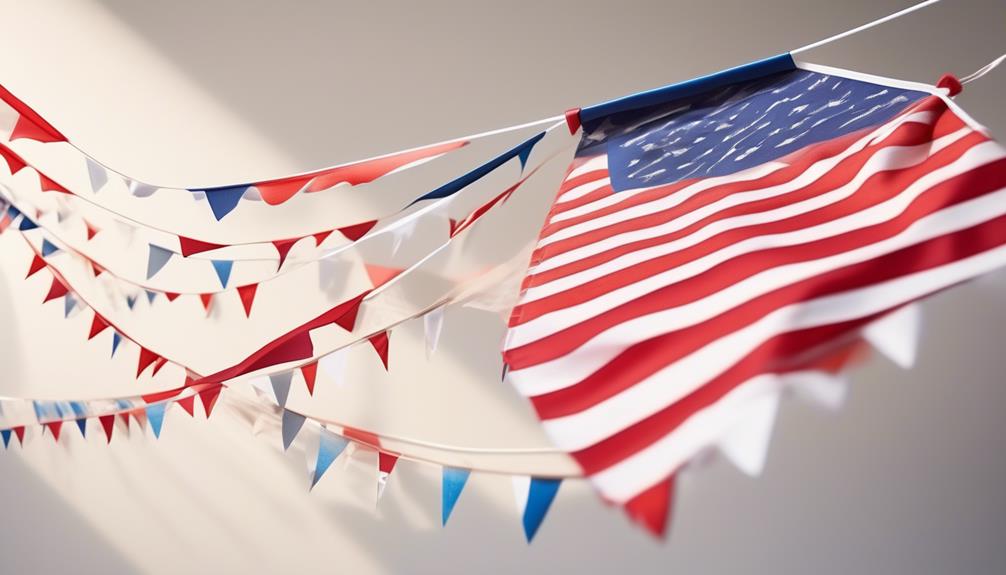
When selecting bunting material for the American flag, it's important to consider the durability and colorfastness of the fabric. Different types of bunting materials offer varying levels of quality and longevity, so it's crucial to make an informed decision when choosing the right material for your flag. Additionally, bunting color options are essential to consider, as the vibrancy and resistance to fading are key factors in maintaining the flag's visual appeal over time.
Here are three common types of bunting material and their characteristics:
- Polyester: This material is a popular choice for American flag bunting due to its excellent durability and color retention. Polyester bunting is also known for its resistance to mildew and UV fading, making it suitable for outdoor use.
- Cotton: Although not as durable as polyester, cotton bunting offers a traditional look and feel. It's often chosen for indoor display or for short-term outdoor use during special events.
- Nylon: Nylon bunting is another durable option that provides excellent colorfastness and resistance to the elements. It's a popular choice for flags flown in high wind areas or areas with frequent inclement weather.
Understanding the characteristics of these bunting materials and their color options will help you make an informed decision when selecting the appropriate material for your American flag.
Bunting Size and Proportions
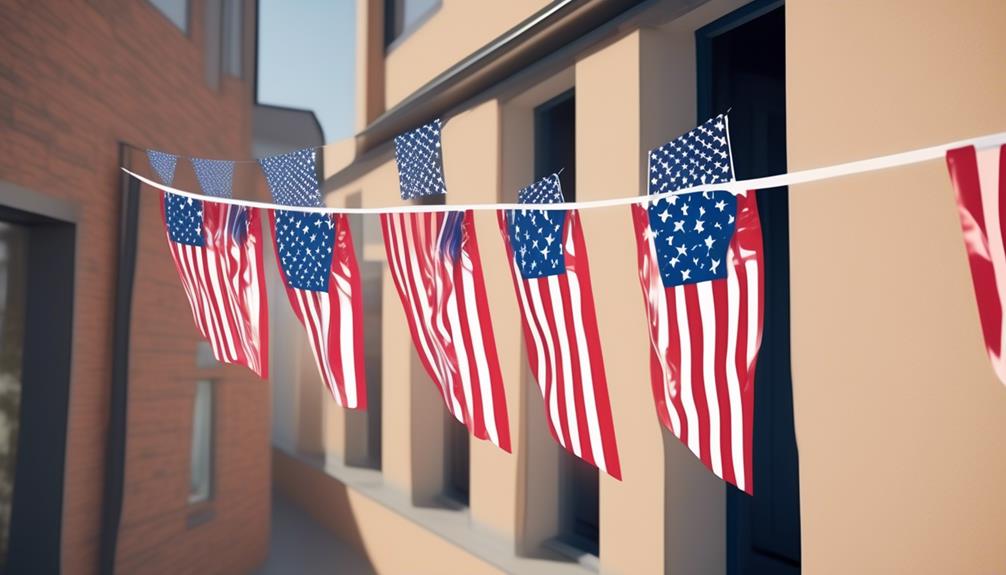
Let's talk about the important aspects of bunting size and proportions for displaying the American flag.
We'll cover the dimensions of bunting and how to ensure it's properly placed for respectful and accurate display.
Understanding these key points is crucial for honoring the flag in the best way possible.
Bunting Dimensions
Understanding the proper dimensions of bunting is essential for displaying the American flag with respect and adherence to flag etiquette. Bunting dimensions must align with the flag's proportions to ensure a proper display and honor the historical significance of the flag.
Bunting Dimensions: Proper Size and Proportions
- Width to Length Ratio: The width of the bunting should be 1/3 of the length to maintain proper proportions with the American flag.
- Standard Sizes: Common bunting sizes for displaying the American flag include 18 inches by 36 inches and 24 inches by 48 inches.
- Material Thickness: Bunting should be made from durable, weather-resistant fabric of appropriate weight to maintain its shape and withstand outdoor display.
Understanding and following these dimensions ensures that the bunting is displayed in a manner that honors the American flag's significance.
Proper Bunting Placement
To ensure proper bunting placement that honors the American flag's significance, we must consider the bunting size and proportions in relation to the flag's dimensions. The bunting size should be proportional to the flag it's adorning, typically using a 1:2 ratio. This means that for every one inch of the flag's width, there should be two inches of bunting width.
The length of the bunting should also be considered, ensuring that it complements the flag's length without overshadowing it. Proper bunting storage is essential to maintain its quality and appearance. When not in use, bunting should be stored in a cool, dry place to prevent any damage.
Additionally, considering bunting material options such as nylon or polyester is crucial for durability and color retention, especially when displaying the American flag outdoors.
Color Guidelines for Bunting
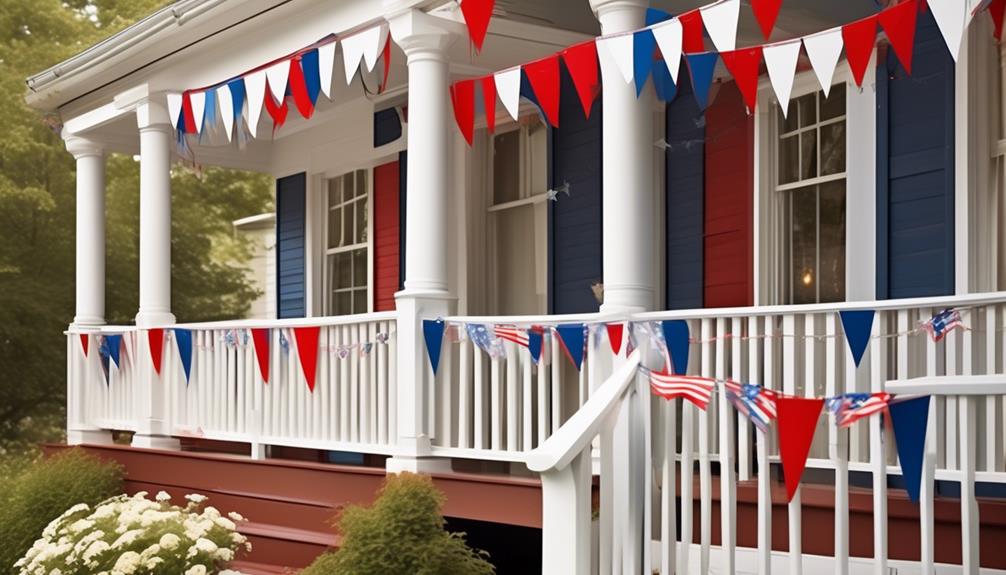
Color guidelines for bunting are a crucial aspect to consider when displaying the American flag. The choice of colors in bunting fabric holds great significance as it represents the values and history of the United States. Understanding the color symbolism and adhering to the color guidelines ensures that the display of the American flag is respectful and accurate.
- Red, White, and Blue: When using bunting fabric to represent the American flag, it's essential to ensure that the colors accurately match the flag's colors. The shades of red, white, and blue should align with the official colors specified for the flag to maintain the integrity of the national symbol.
- Color Symbolism: The color symbolism of the American flag should be reflected in the bunting. Red symbolizes hardiness and valor, white signifies purity and innocence, and blue represents vigilance, perseverance, and justice. Adhering to these color meanings in the bunting reinforces the patriotic significance of the display.
- Consistency: When using bunting to decorate or display the American flag, it's important to maintain consistency in the colors used. Consistent color guidelines ensure that the representation of the flag remains accurate and respectful across different displays and occasions.
Understanding the color guidelines for bunting is essential for maintaining the integrity and symbolism of the American flag in various displays and events.
Proper Placement of Bunting
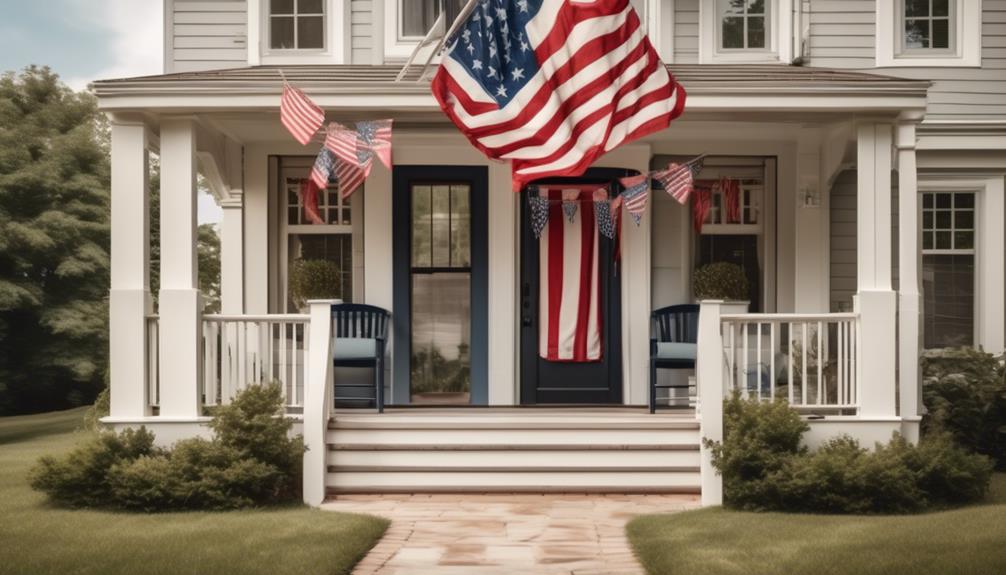
Let's talk about the proper placement of bunting, specifically on buildings and vehicles.
When it comes to displaying the American flag with bunting, there are specific rules to follow for both buildings and vehicles. Understanding the guidelines for each placement is essential to show proper respect for the flag.
Bunting on Buildings
When adorning buildings with bunting, it's essential to ensure that it's placed in a respectful and dignified manner. To achieve this, we must consider the following:
- Bunting Material Options: Choose durable, weather-resistant materials such as nylon or polyester to ensure longevity and maintain a neat appearance. These materials are better suited for outdoor use and can withstand various weather conditions, ensuring that the bunting looks presentable for an extended period.
- Building Code Restrictions, Permits: Before installing bunting on a building, it's crucial to review local building codes and obtain any necessary permits. Compliance with regulations ensures that the bunting is displayed safely and doesn't obstruct emergency exits or pose any hazards.
- Proper Placement: Bunting should be placed evenly and securely to prevent it from sagging or becoming disheveled. Properly securing the bunting ensures a tidy and respectful display of patriotism on the building.
Adhering to these considerations will help maintain a dignified and appropriate appearance when adorning buildings with bunting.
Bunting on Vehicles
As we shift our focus to bunting on vehicles, it's crucial to ensure that it's securely and respectfully placed, in a manner consistent with the dignified display of patriotism on buildings.
When affixing bunting on motorcycles, it should be secured firmly to prevent interference with the operation of the vehicle. Avoid obstructing any lights, signals, or the license plate.
For boats, bunting should be fastened securely to withstand wind and water conditions. It shouldn't impede the visibility of navigation lights or compromise the safety of the vessel.
Additionally, it's important to consider the material of the bunting to ensure it withstands outdoor elements.
Whether it's on motorcycles or boats, the proper placement of bunting on vehicles is essential to uphold the reverence and respect for the American flag.
Bunting on Buildings
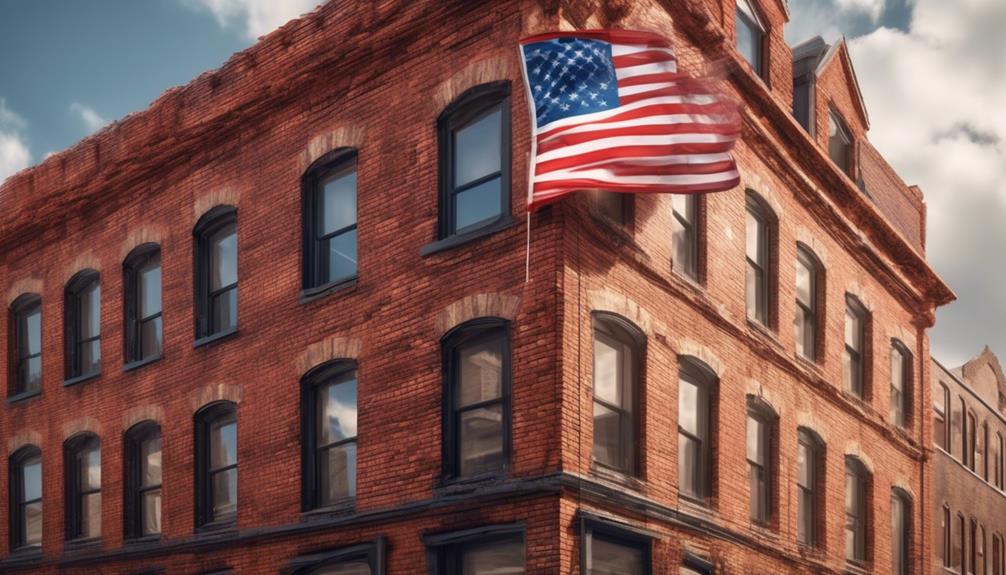
Bunting on buildings is a traditional way to display the American flag for special occasions and events. It adds a touch of patriotism and festivity to the exterior of a building, making it an eye-catching decoration.
When using bunting to adorn buildings, there are a few key considerations to keep in mind:
- Bunting Material: The material used for bunting on buildings should be durable and weather-resistant. Nylon and polyester are popular choices due to their ability to withstand outdoor conditions such as rain and wind. These materials also provide vibrant colors, ensuring that the bunting maintains its visual appeal over time.
- Building Decoration: When hanging bunting on a building, it's important to ensure that it's done in a respectful and proper manner. Bunting should be securely fastened and positioned in a way that doesn't obstruct any architectural features or signage on the building. Careful attention to detail can enhance the overall aesthetics of the display.
- Regulations and Etiquette: Before adorning a building with bunting, it's essential to familiarize oneself with any local regulations or guidelines regarding the display of the American flag. Additionally, understanding proper flag etiquette, including the respectful handling and maintenance of the bunting, is crucial for a tasteful and meaningful display.
Bunting for Parades and Events
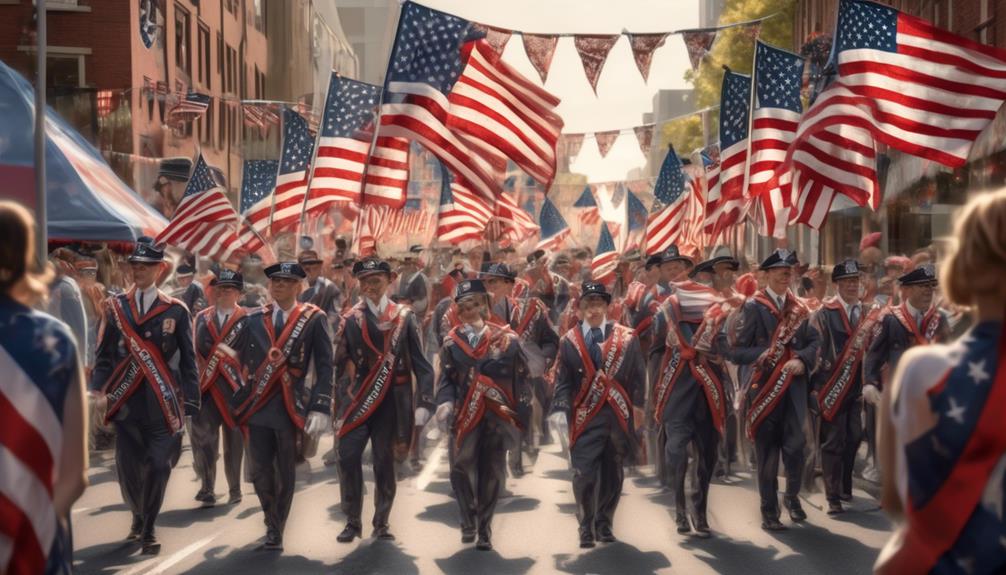
Before adorning a building with bunting, we must consider the appropriate use of bunting for parades and events. When preparing bunting for parades and events, it is crucial to select materials that offer durability and can withstand outdoor conditions. The bunting design should reflect creativity and enhance the festive atmosphere of the event.
| Bunting Materials | Durability |
|---|---|
| Nylon | High |
| Polyester | High |
When it comes to bunting materials, nylon and polyester are popular choices due to their durability. Nylon is known for its strength and ability to withstand harsh weather conditions, making it a reliable option for outdoor events. Similarly, polyester is highly durable and resistant to stretching and shrinking, ensuring that the bunting maintains its pristine appearance throughout the event.
| Bunting Design | Creativity |
|---|---|
| Color Variety | High |
| Custom Printing | High |
In terms of bunting design, incorporating a wide variety of colors can contribute to the vibrancy of the event. Additionally, custom printing allows for personalized messages or branding, adding a creative touch to the bunting display. By carefully considering bunting materials and design, we can ensure an eye-catching and enduring display for parades and events.
Bunting on Vehicles
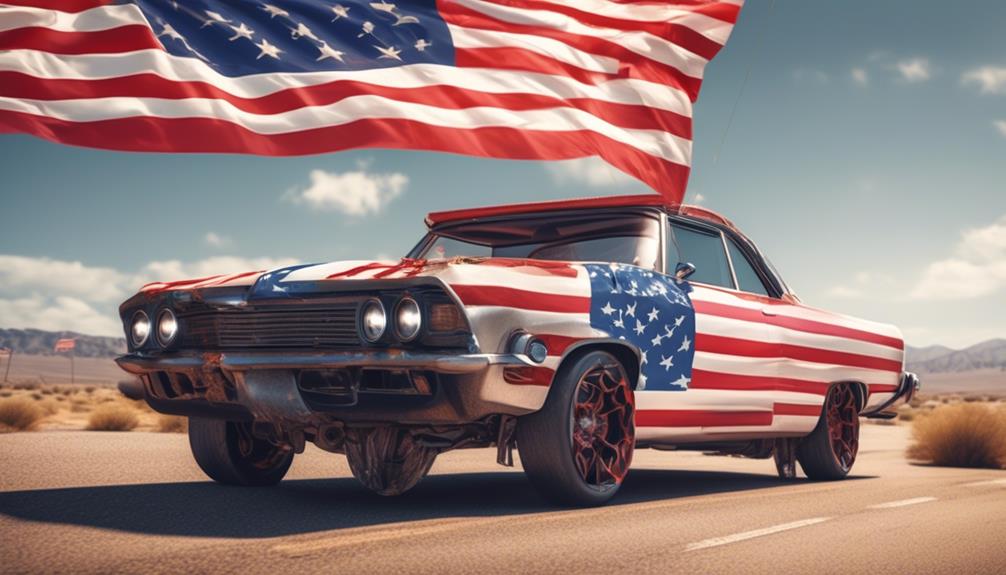
When decorating vehicles with bunting for events or parades, we prioritize using durable materials that can withstand outdoor conditions. Ensuring bunting safety and secure attachment is crucial for a successful and safe display.
Here are three essential considerations for bunting on vehicles:
- Material Quality: Opt for high-quality, weather-resistant fabrics when selecting bunting for vehicles. Materials such as nylon or polyester are durable and can endure various weather conditions without fading or tearing, ensuring bunting safety and longevity.
- Secure Attachment: Utilize reliable attachment methods to secure the bunting to the vehicle. Avoid using adhesives that may damage the vehicle's paint. Instead, consider using magnetic clips, bungee cords, or specially designed vehicle bunting clips to ensure a secure and non-damaging attachment.
- Visibility and Clearance: When installing bunting on vehicles, ensure that it doesn't obstruct the driver's visibility or interfere with any moving parts of the vehicle. Secure the bunting in a way that maintains clear lines of sight and doesn't pose any safety hazards while the vehicle is in motion.
Bunting on Flagpoles
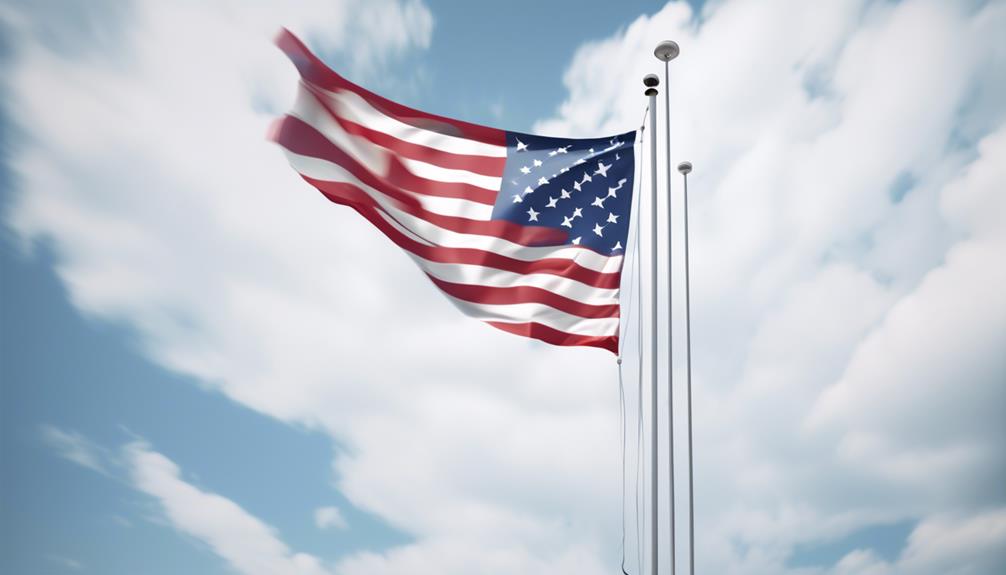
How can bunting be properly displayed on flagpoles to ensure respect for the American flag? When displaying bunting on flagpoles, it is essential to adhere to proper flag etiquette to honor the flag and the nation it represents. Proper bunting etiquette on flagpoles involves ensuring that the bunting does not touch the ground and is maintained in a clean and tidy condition. Here are some key points to consider for displaying bunting on flagpoles:
| Dos | Don'ts |
|---|---|
| Ensure the bunting is securely fastened to the flagpole | Avoid allowing the bunting to become tattered or faded |
| Regularly inspect the bunting for any signs of wear or damage | Do not let the bunting touch the ground or any unsuitable surface |
| Keep the bunting clean and well-maintained | Do not use bunting that is too large for the flagpole or looks disproportionate |
| Display the bunting in a respectful manner, in line with flag etiquette | Avoid using bunting that is not in line with the colors and themes of the American flag |
| Consider the weather conditions when displaying bunting | Do not leave bunting on the flagpole when it is not in use or during inclement weather |
Adhering to these guidelines ensures that bunting on flagpoles is displayed with the utmost respect for the American flag. Proper bunting maintenance and adherence to flag etiquette are crucial in preserving the dignity of the flag and the nation it represents.
Bunting Etiquette
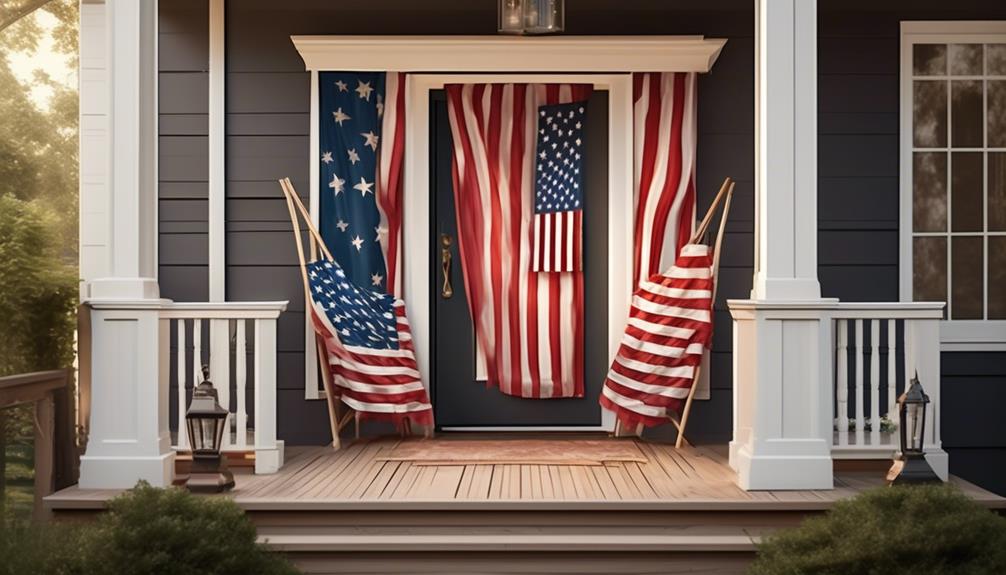
We always ensure that bunting is displayed with the utmost respect for the American flag, following proper etiquette guidelines. When it comes to bunting etiquette, there are important considerations regarding the materials used, their durability, as well as proper storage and maintenance.
- Bunting Materials and Durability: We prioritize using high-quality, durable materials for our bunting to ensure longevity and a respectful display. Materials such as heavy-duty cotton, polyester, or nylon are commonly used for their ability to withstand outdoor elements and maintain their vibrant colors, thus honoring the flag they represent.
- Proper Storage and Maintenance: It's crucial to store bunting properly when not in use. This includes ensuring it's clean and completely dry before storing to prevent any damage or mildew. Additionally, regular maintenance such as gentle cleaning and inspection for wear and tear helps to uphold the bunting's integrity and respect for the flag.
Bunting Maintenance and Care
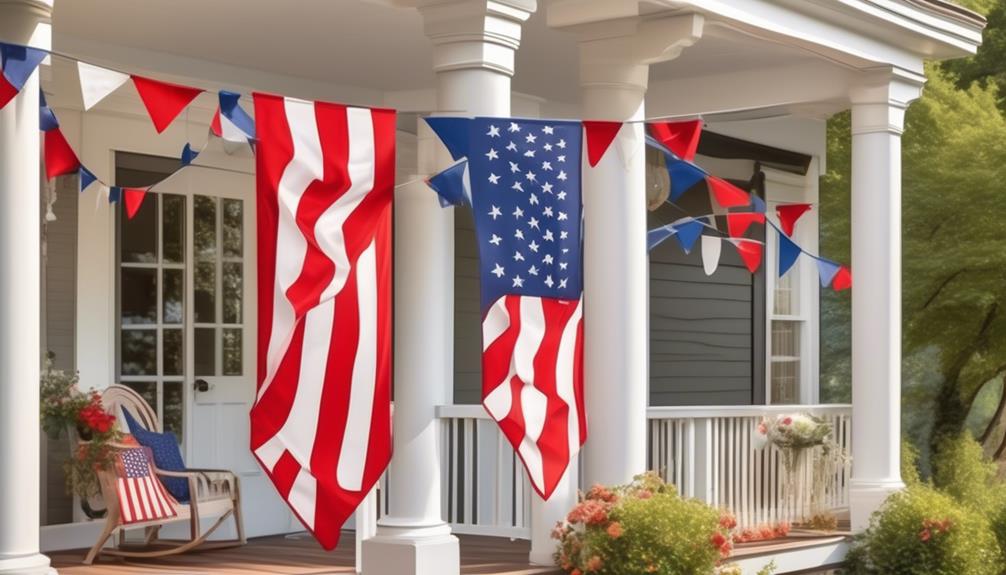
Ensuring the longevity and vibrancy of our bunting requires regular maintenance and careful storage practices. Proper bunting storage is essential for preserving its colors and fabric.
When not in use, bunting should be stored in a clean, dry, and well-ventilated area. Ideally, it should be kept in a dark place to minimize exposure to light, which can cause fading over time. It's important to avoid folding or creasing the bunting for extended periods, as this can lead to permanent wrinkles and damage the fabric. Instead, consider rolling the bunting and storing it in a protective container to prevent any potential damage.
Additionally, weatherproofing the bunting is crucial for protecting it from the elements. Applying a fabric protectant spray can help repel moisture and prevent mildew growth, especially if the bunting will be displayed outdoors. Before applying any products, always check the manufacturer's recommendations and conduct a spot test to ensure compatibility with the fabric.
Bunting for Patriotic Holidays
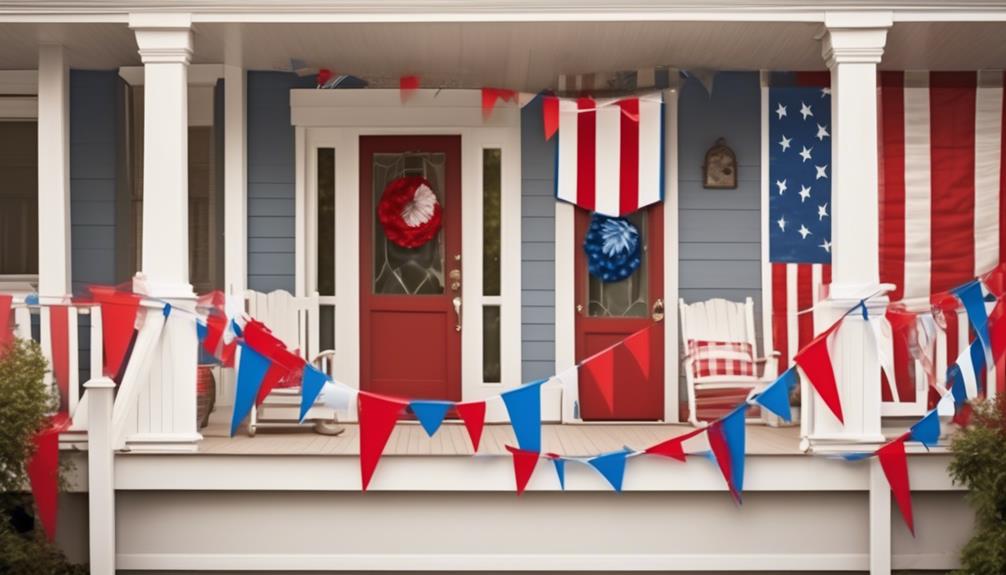
Celebrating patriotic holidays with vibrant and well-maintained bunting adds a festive touch to our gatherings and displays. Bunting traditions have long been a part of our patriotic celebrations, and understanding their symbolism can deepen our appreciation for these traditions.
Here are three essential points to consider when using bunting for patriotic holidays:
- Historical Significance: Bunting has been a part of American patriotic traditions since the early days of the nation. Understanding the historical significance of bunting helps us appreciate its role in our celebrations and fosters a deeper connection to our heritage.
- Symbolism of Colors: The colors of bunting hold significant symbolism. Red symbolizes hardiness and valor, white represents purity and innocence, and blue signifies vigilance, perseverance, and justice. Utilizing bunting with these colors enhances the symbolism and spirit of patriotic holidays.
- Proper Display: When using bunting for patriotic holidays, it's essential to ensure proper display and maintenance. Bunting should be securely fastened and well-maintained to show respect for the flag and the occasion.
Understanding bunting traditions and their symbolism can elevate the significance of patriotic holidays, fostering a deeper sense of national pride and unity.
Bunting for Special Occasions
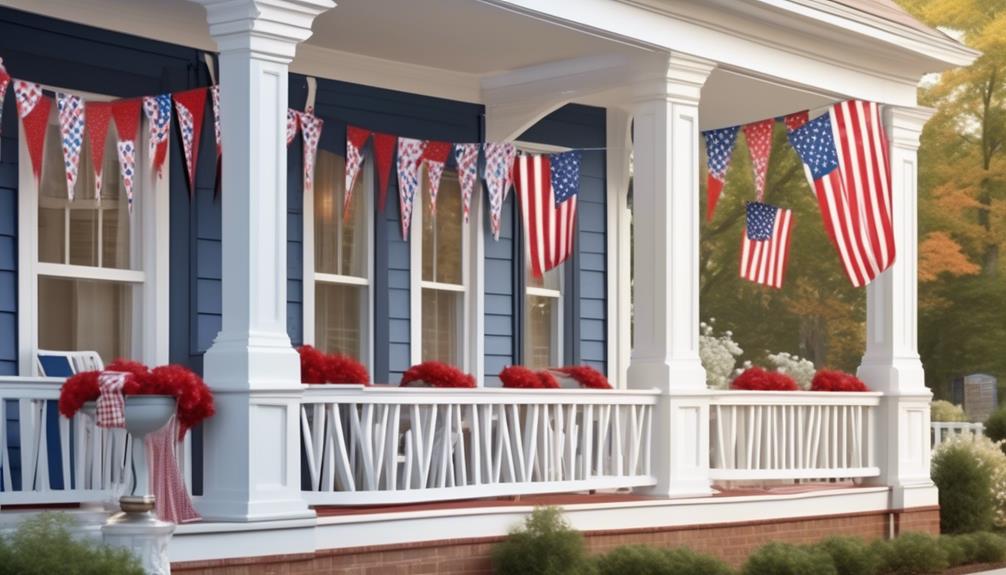
Bunting for special occasions enhances the festive atmosphere, and understanding its diverse uses can add depth to our celebrations. Bunting traditions have long been intertwined with ceremonial occasions, bringing a sense of grandeur and solemnity to events. Whether adorning the halls of government buildings during state visits or gracing the streets for parades and festivals, bunting plays a crucial role in signaling the importance of these special occasions.
Ceremonial occasions call for bunting to be displayed with precision and care, adhering to established customs and guidelines. The colors and arrangement of bunting can convey specific meanings, symbolizing themes such as national pride, remembrance, or celebration. Understanding these nuances allows us to pay homage in a respectful and meaningful manner.
From grand state ceremonies to joyous community celebrations, bunting serves as a visual representation of the significance of the occasion. Its use is steeped in tradition and symbolism, adding an air of dignity to the proceedings. By respecting and upholding bunting traditions, we enrich our special occasions with a timeless and profound sense of history and purpose.
Frequently Asked Questions
Can Bunting Be Used in Place of an Actual American Flag for Display?
Yes, bunting can be used as an alternative for displaying the American flag.
When discussing bunting etiquette and traditions, it's important to note that using bunting in place of an actual flag is a common practice, especially for decorative purposes during celebrations or events.
However, it's essential to ensure that the bunting accurately represents the flag's colors and design, adhering to the appropriate guidelines for respectful display.
Is There a Specific Way to Fold and Store Bunting When Not in Use?
When it comes to folding and storing bunting, proper care and preservation are essential. Handling it with care ensures its longevity. A fascinating statistic is that bunting, when maintained correctly, can last for many years.
To ensure its preservation, we recommend folding it neatly and storing it in a cool, dry place. Regularly inspecting it for any signs of wear and tear is also crucial for its maintenance.
Are There Any Restrictions on Using Bunting in Advertising or Commercial Settings?
In commercial settings, bunting regulations dictate that it's important to be mindful of the proper display of bunting to avoid it being mistaken for a flag replacement. It's essential to adhere to the guidelines to maintain respect for the flag.
When not in use, bunting should be folded and stored appropriately. This ensures its longevity and proper display when needed.
Understanding these regulations is crucial for anyone using bunting in advertising or commercial settings.
Can Bunting Be Used in Conjunction With Other National Flags or Banners?
When it comes to bunting etiquette and national flag decorum, it's essential to consider the significance and respect associated with each flag.
Using bunting in conjunction with other national flags or banners should be approached with careful consideration for the symbolism and representation it entails.
Proper placement and respectful display of multiple national flags or banners is crucial to honoring the heritage and pride they represent.
Are There Any Guidelines for Disposing of Old or Damaged Bunting?
When it comes to bunting disposal, etiquette is key. Properly recycling damaged bunting is essential to uphold respect for our national symbols.
It's important to follow guidelines for the respectful disposal of old or damaged bunting, ensuring it's done in a dignified manner.
Recycling damaged bunting can be a meaningful way to honor its significance and contribute to environmental sustainability.
Are There Specific Rules for Displaying Balloon Decorations with the American Flag?
When displaying balloon decorations with the American flag, it’s important to follow specific rules of etiquette. The average cost of balloon arch can vary depending on size and design. Ensure that balloons do not touch the flag, and use colors that complement rather than detract from the flag’s symbolism.
Conclusion
In conclusion, bunting the American flag is a way to show patriotic pride and honor special occasions.
While some may see bunting as an outdated tradition, it serves as a visual representation of the values and history that make America great.
By respecting the rules for bunting the flag, we uphold the ideals of unity and respect for our country, reminding us of the sacrifices made by those who came before us.
- About the Author
- Latest Posts
Introducing Ron, the home decor aficionado at ByRetreat, whose passion for creating beautiful and inviting spaces is at the heart of his work. With his deep knowledge of home decor and his innate sense of style, Ron brings a wealth of expertise and a keen eye for detail to the ByRetreat team.
Ron’s love for home decor goes beyond aesthetics; he understands that our surroundings play a significant role in our overall well-being and productivity. With this in mind, Ron is dedicated to transforming remote workspaces into havens of comfort, functionality, and beauty.
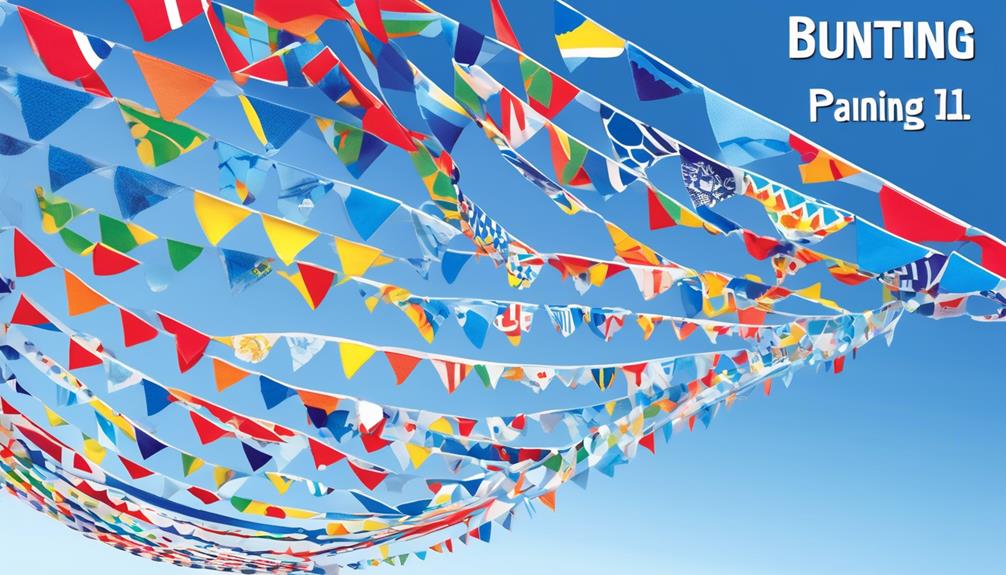
Have you ever thought about why bunting is named bunting?
It's like peeling back the layers of a mysterious package, each layer revealing a little more about its origins and cultural significance. The evolution of its name is a fascinating journey that takes us through different languages and historical contexts.
But there's more to it than just etymology; bunting holds a unique place in various cultures and has a modern appeal that continues to captivate.
So, let's unravel the mystery and discover the intriguing story behind why bunting is called bunting.
Key Takeaways
- The word 'bunting' originated from the Old French word 'bontin' and was initially used for maritime flag communication.
- Over time, 'bunting' evolved into festive decorations for land-based celebrations.
- Bunting is deeply ingrained in traditional celebrations worldwide and symbolizes unity, patriotism, and celebration.
- Bunting is a versatile decorative element that adds nostalgia and whimsy to events and settings.
Origins of Bunting

The origins of bunting can be traced back to ancient civilizations, where evidence of this decorative practice has been found in archaeological discoveries. The etymology of the word 'bunting' is thought to have originated from the Old French word 'bontin,' meaning 'colorful' or 'painted canvas.'
Historical origins suggest that bunting was initially used as a form of maritime flag communication, with colorful flags being used to send messages between ships. Over time, this practice extended to land-based celebrations and decorations, evolving into the festive bunting we recognize today.
In ancient times, bunting was made from various materials such as cotton, wool, and even silk, and was often adorned with intricate designs and patterns. The use of bunting as a decorative element became widespread during the 17th and 18th centuries, particularly in Europe and the United States, where it was used to embellish public spaces during festive occasions and celebrations.
Understanding the historical roots of bunting provides insight into its cultural significance and enduring appeal as a decorative art form.
Evolution of Bunting's Name
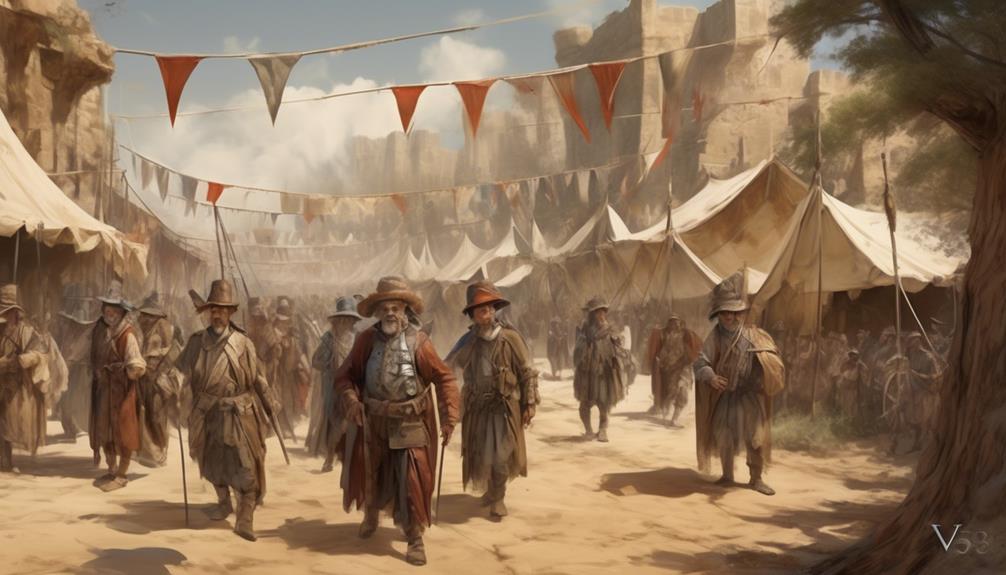
Tracing the etymology of the word 'bunting' leads us to the Old French term 'bontin,' which originally denoted 'colorful' or 'painted canvas,' providing insight into the evolution of bunting's name. Over time, the term 'bontin' transitioned into 'buntine' in Middle English, referring to a lightweight open fabric used for sieves or nets. This transformation reflects the evolving use of the material, shifting from decorative purposes to more functional applications.
As the English language continued to develop, 'buntine' gradually transformed into 'bunting,' expanding its meaning to encompass various types of loosely woven fabrics, particularly those used for flags and festive decorations. The semantic shift from a specific type of fabric to a broader category reflects the linguistic evolution of the term. This evolution demonstrates how language adapts to accommodate changes in material use and cultural practices.
Understanding the evolution of bunting's name provides valuable insights into the historical contexts in which the term was used and the cultural significance attached to it. Etymological analysis allows us to trace the trajectory of bunting's name, highlighting its journey from a colorful canvas to a diverse category of loosely woven fabrics.
Cultural Significance of Bunting
Exploring the cultural significance of bunting sheds light on its historical and symbolic resonance within various societal contexts. Bunting, with its origins as a maritime signal and festive decoration, has become deeply ingrained in traditional celebrations and symbolic decorations across the world. Its presence in cultural and historical events has made it an enduring symbol of unity, celebration, and national pride.
| Traditional Celebrations | Symbolic Decorations |
|---|---|
| Bunting is often used in traditional celebrations such as national holidays, weddings, and festivals, where it adorns streets, buildings, and parade floats, adding to the festive atmosphere. | As a symbolic decoration, bunting signifies unity, patriotism, and celebration. It is often used to represent national colors, bringing a sense of pride and identity to public spaces and events. |
This enduring tradition of using bunting for decorative and symbolic purposes has made it a beloved and recognizable feature in cultural celebrations. As societies continue to evolve, bunting remains a timeless emblem of joy and unity, connecting people across generations and cultures in moments of celebration and national pride.
Bunting in Different Languages
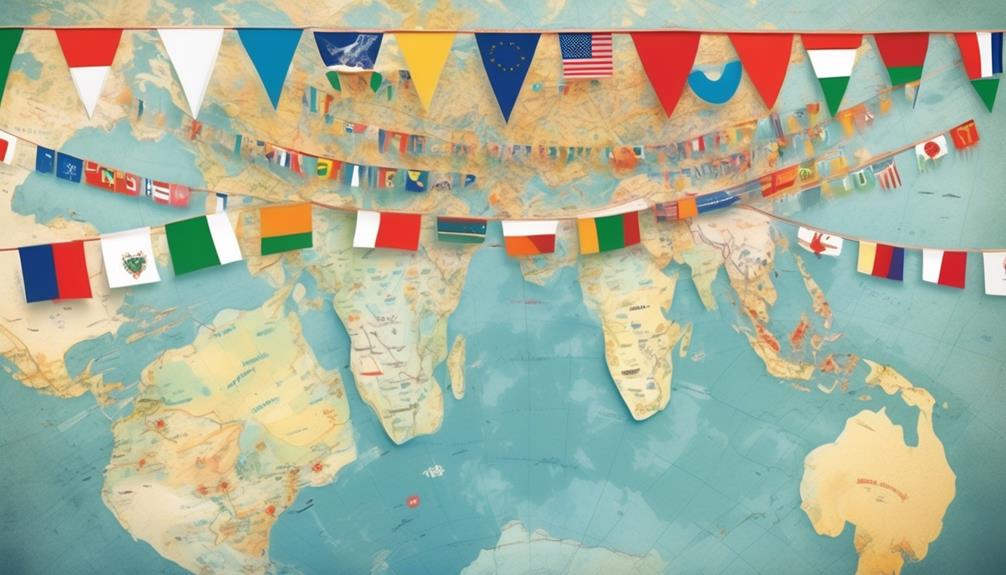
In understanding the cultural significance of bunting, it becomes apparent that its presence isn't confined to a single language, as its use and symbolism extend across various linguistic traditions.
Language variations in the use of bunting reveal its historical context and diverse cultural interpretations. In English, the term 'bunting' originally referred to the lightweight woolen cloth used for making flags, and its usage later extended to decorative flags and streamers.
In Spanish, 'banderines' or 'guirnaldas' are terms used for decorative bunting, reflecting the rich tradition of vibrant fiestas and celebrations in Hispanic cultures.
The French refer to bunting as 'fanions' or 'guirlandes,' reflecting their historical use in military and festive contexts.
German and Dutch languages use 'Wimpel' and 'vlaggetjes' respectively to denote bunting, reflecting the cultural significance of decorative flags in these societies.
These language variations highlight the historical context of bunting as a universal symbol of celebration, festivity, and cultural identity, transcending linguistic boundaries.
The Modern Appeal of Bunting
The modern appeal of bunting lies in its versatile use as a decorative element that adds a touch of nostalgia and whimsy to various events and settings. In today's context, bunting has found a place in modern aesthetics, offering a charming and elegant way to enhance the visual appeal of spaces. Its ability to evoke a sense of nostalgia while still feeling fresh and contemporary has contributed to its enduring popularity.
Creative applications of bunting have expanded its appeal, making it a staple in events ranging from intimate gatherings to large-scale festivals. Its ability to transform ordinary spaces into enchanting settings has made it a favorite among event planners and individuals alike. The creative use of colors, patterns, and materials has allowed bunting to adapt to a wide range of themes and styles, from rustic and vintage to modern and eclectic.
Moreover, its association with traditional celebrations and outdoor events has contributed to its modern appeal, as it brings a sense of warmth and conviviality to any setting. The enduring charm of bunting lies in its ability to infuse spaces with a sense of joy and celebration, making it a beloved decorative element in the contemporary world.
Frequently Asked Questions
What Are the Different Types of Materials Used to Make Bunting?
Types of materials used to make bunting include fabric, plastic, paper, and felt. These materials offer versatility for creative applications, such as outdoor decorations, party decor, and festive events.
Additionally, bunting materials can be repurposed for alternative uses, such as crafting and DIY projects. Each material brings unique qualities to bunting, allowing for diverse customization and visual appeal in various settings.
Is Bunting Only Used for Decorative Purposes, or Does It Have Other Practical Uses?
Practical uses of bunting extend beyond mere decoration. Its versatility makes it ideal for creative applications. Although often associated with festive occasions, bunting has practical uses in maritime signaling, aviation, and even military contexts.
Its vibrant colors and eye-catching design also make it a valuable tool for advertising and safety markings. The historical evolution of bunting's practical applications showcases its enduring significance in various fields.
Are There Any Specific Traditions or Customs Associated With the Use of Bunting in Different Cultures?
In different cultures, bunting carries significant cultural significance and is often intertwined with historical origins. Various traditions and customs are associated with its use, reflecting the diverse ways it's utilized for celebrations and events.
The historical origins of bunting reveal its evolution and continued relevance in different cultural contexts, shedding light on its enduring importance. Understanding these traditions and historical connections provides insight into the rich tapestry of meanings associated with bunting.
How Has the Popularity of Bunting Changed Over Time?
The evolution of bunting's popularity has been fascinating. Over time, it has transitioned from a traditional decorative element to a symbol of celebration and festivity.
The cultural significance of bunting has grown, becoming a ubiquitous feature at events and gatherings. Its colorful and cheerful nature has made it a beloved adornment, reflecting the joyous spirit of various occasions.
This shift in perception has contributed to the enduring appeal of bunting across different cultures.
Are There Any Superstitions or Beliefs Surrounding the Use of Bunting in Certain Cultures?
Superstitions and cultural significance surrounding bunting vary widely across different cultures. In some societies, bunting is believed to bring good luck and ward off evil spirits when displayed during celebrations and festivals.
Conversely, in other traditions, there are superstitions associated with the colors and patterns of bunting, with specific combinations believed to attract prosperity or protect against misfortune.
Understanding these beliefs adds depth to the history and use of bunting in diverse cultures.
Is There a Cultural Significance Behind the Name “Bunting” and the Tradition of Cake Smashing?
The tradition of cake smashing has become a popular trend in recent years, with many couples incorporating it into their wedding festivities. While the reasons for cake smashing vary, it is often seen as a fun and lighthearted way to celebrate the joy of marriage. As for the cultural significance behind the name “Bunting”, it is often associated with festive and celebratory occasions, making it a fitting choice for a wedding tradition like cake smashing.
Conclusion
In tracing the origins of bunting and its name, we've uncovered a rich history of cultural significance and evolution. From its humble beginnings to its modern appeal, bunting has woven itself into the fabric of our lives.
Its colorful presence brings joy and celebration, like a fluttering array of flags in the wind, symbolizing unity and festivity across different cultures and languages.
The name 'bunting' may have a simple origin, but its impact is profound and enduring.
- About the Author
- Latest Posts
Introducing Ron, the home decor aficionado at ByRetreat, whose passion for creating beautiful and inviting spaces is at the heart of his work. With his deep knowledge of home decor and his innate sense of style, Ron brings a wealth of expertise and a keen eye for detail to the ByRetreat team.
Ron’s love for home decor goes beyond aesthetics; he understands that our surroundings play a significant role in our overall well-being and productivity. With this in mind, Ron is dedicated to transforming remote workspaces into havens of comfort, functionality, and beauty.

As we explore the numerous cruise choices leaving from San Francisco, it is interesting to observe that the city’s cruise terminal experienced a 9% rise in passenger traffic last year. With a wide variety of destinations and experiences available, it is no surprise that San Francisco has become a vibrant center for cruise enthusiasts.
But before we set sail into the details of the best cruises from this iconic port, let's take a moment to consider the unique allure of embarking on a voyage from the City by the Bay.
Key Takeaways
- San Francisco cruise terminal experienced a 9% increase in passenger traffic last year.
- The Alaskan adventure cruise offers wildlife encounters and glacial exploration.
- The Hawaiian Paradise cruise offers island-hopping delights and diverse Hawaiian cuisine.
- The Mexican Riviera cruise offers sun, sand, Mexican cuisine, and captivating cultural experiences.
Alaskan Adventure: Discover the Wild North

Embark on an unforgettable Alaskan adventure and discover the untamed beauty of the Wild North with our exhilarating cruise from San Francisco. As you set sail, be prepared for awe-inspiring wildlife encounters.
The crisp, salty air fills your lungs as you scan the horizon for a glimpse of a breaching humpback whale or a majestic bald eagle soaring overhead. The pristine waters teem with life, offering a chance to witness playful otters and curious seals as they navigate their natural habitat.
Glacial exploration is a cornerstone of our Alaskan adventure. Feel the chill in the air as you approach these ancient rivers of ice. Towering glaciers command attention with their breathtaking beauty and raw power. Witness the spectacle of massive ice calving into the sea, creating a thunderous roar that reverberates through the fjords. Our expert guides provide captivating insights into the geological forces that have shaped this unique landscape over millennia.
With wildlife encounters and glacial exploration awaiting at every turn, our Alaskan adventure promises an enriching and unforgettable experience.
Pacific Coast Escapade: Scenic Coastal Cruises

Meandering along the Pacific Coast, our scenic coastal cruises offer a captivating blend of breathtaking vistas and tranquil seascapes, inviting you to immerse yourself in the natural beauty of the West Coast.
As we sail along this stunning coastline, passengers are treated to unparalleled scenic views of rugged cliffs, pristine beaches, and charming coastal towns. The relaxing atmosphere on board complements the serene surroundings, allowing guests to unwind and fully appreciate the awe-inspiring sights.
From the comfort of the ship, passengers can witness the dramatic beauty of the Pacific Coast unfold before their eyes. The ever-changing scenery, from majestic rock formations to lush forests meeting the sea, creates a picturesque backdrop for a truly unforgettable journey. Our expert crew is dedicated to ensuring that every guest has the opportunity to savor these remarkable views, whether from spacious deck areas or through panoramic windows in the ship's common areas.
With an emphasis on providing an enriching and rejuvenating experience, our scenic coastal cruises are designed for those seeking a deeper connection with nature and a profound appreciation for the wonders of the Pacific Coast. Whether you're a seasoned traveler or embarking on your first cruise, our Pacific Coast escapade promises an unparalleled blend of relaxation and natural beauty.
Hawaiian Paradise: Island-Hopping Delights
As we set sail for the Hawaiian Paradise, prepare to be captivated by the allure of island-hopping delights that await us in the tranquil waters of the Pacific. Our journey through the Hawaiian Islands promises an enchanting blend of tropical beaches and vibrant culture. From the moment we arrive at the first island, the air is filled with the scent of plumeria and the sound of ukuleles, beckoning us to immerse ourselves in the local rhythm.
Each island offers its own unique charm, from the stunning volcanic landscapes of the Big Island to the lush rainforests of Kauai.
Our adventure will take us to Maui, where we can bask in the beauty of the famous Road to Hana, and to Oahu, where we can explore the historic sites of Honolulu and surf the legendary waves of the North Shore. The island-hopping experience allows us to sample the diverse flavors of Hawaiian cuisine, from traditional luau feasts to innovative farm-to-table dining experiences.
With its rich history, breathtaking natural wonders, and warm hospitality, the Hawaiian Paradise is a destination that promises an unforgettable journey through some of the most beautiful islands in the world.
Mexican Riviera Exploration: Sun, Sand, and Culture

Exploring the Hawaiian Paradise has been an unforgettable journey, and now we're thrilled to set our sights on the vibrant Mexican Riviera, where sun, sand, and culture await us for an enriching exploration.
The Mexican Riviera is a treasure trove of experiences, offering breathtaking beach activities, a rich tapestry of local cuisine, traditional dances, and fascinating historical sites.
As we step onto the soft, golden sands, we'll be greeted by the rhythmic beats of traditional music and the aroma of delectable, authentic Mexican dishes. The beaches here are perfect for diving into thrilling water sports or simply lounging under the warm, tropical sun.
Our taste buds will be tantalized by the flavors of freshly caught seafood, zesty salsas, and mouthwatering tacos. Moreover, the Mexican Riviera's captivating culture comes alive through vibrant traditional dances and the opportunity to explore historical sites like the ancient Mayan ruins.
This journey promises to be an immersive experience, where every moment is filled with the colors, flavors, and rhythms of this captivating region.
Transpacific Voyages: Epic Ocean Crossings
Embarking on transpacific voyages offers a thrilling opportunity to experience epic ocean crossings that traverse vast expanses of open water, connecting diverse and captivating destinations. As we prepare to set sail on these extraordinary maritime adventures, we're filled with anticipation for the historical significance and cultural exchange that awaits us.
Here's why transpacific voyages are a must for those seeking international exploration:
- Historical Significance: These voyages trace the routes of ancient explorers, connecting the Pacific Rim and playing a pivotal role in shaping world history.
- Maritime Adventures: From the moment we embark, we're immersed in the legacy of seafaring, experiencing the thrill of navigating the open sea while learning about the rich maritime heritage.
- Cultural Exchange: As we cross the vast Pacific, we anticipate the opportunity to engage with diverse cultures, languages, and traditions, fostering a deep appreciation for global diversity.
- International Exploration: Transpacific voyages open the door to a world of exploration, offering access to remote islands, bustling metropolises, and everything in between, making it an unforgettable journey of discovery.
Prepare to be captivated by the allure of transpacific voyages, where the call of adventure meets the embrace of international discovery.
Frequently Asked Questions
What Are the Onboard Entertainment Options for Families With Young Children on These Cruises?
We offer various onboard entertainment options for families with young children, including childcare facilities and kids clubs. These spaces are designed to provide a safe and engaging environment for kids to have fun while parents enjoy other activities.
Additionally, we offer a wide range of entertainment and activities suitable for all ages, ensuring that the whole family can enjoy their time on the cruise.
Are There Any Special Dining Options or Culinary Experiences Available on These Cruises?
We love the culinary workshops and specialty restaurants on these cruises.
The culinary workshops offer a hands-on experience, teaching us new cooking techniques and recipes.
The specialty restaurants provide a diverse array of gourmet dining options, from fine dining to international cuisines.
It's a delightful way to explore different flavors and indulge in unique culinary experiences while sailing the seas.
What Are the Vaccination and Health Requirements for Passengers on These Cruises?
Vaccination requirements and health screenings are essential for passengers on these cruises. It's crucial to ensure all travelers are up to date with their vaccinations and pass health screenings before boarding.
Additionally, having travel insurance is wise, and knowing the availability of medical facilities on the cruise is important for peace of mind.
These measures contribute to a safe and enjoyable experience for everyone on board.
Can Passengers Bring Their Own Alcohol on Board or Is It Available for Purchase?
Yes, passengers are responsible for adhering to the alcohol policy. Most cruises offer the option to purchase alcohol onboard. However, bringing one's own alcohol is generally not allowed due to safety and security reasons.
The onboard facilities usually include bars and lounges where passengers can purchase a variety of alcoholic beverages. It's important to check with the specific cruise line for their purchasing options and policies regarding alcohol consumption.
Are There Any Specific Packing Tips or Dress Code Recommendations for These Cruises?
When it comes to packing for cruises, it's essential to consider the destination and activities. For warm destinations, lightweight clothing, bathing suits, and sunscreen are must-haves.
For cooler climates, layers and a waterproof jacket are essential.
As for dress codes, most cruises have formal nights, so packing a cocktail dress or suit is a good idea. Check the specific cruise line's guidelines to ensure you're prepared for all occasions.
Are There Any Cruises From San Francisco That Cater to 18 Year Olds?
Yes, there are best cruise options for teens from San Francisco. Many cruise lines offer sailings that cater to 18-year-olds with activities, entertainment, and excursions suitable for young adults. From adventurous activities to vibrant nightlife, these cruises provide a great mix of fun for 18-year-olds.
Conclusion
We hope you've enjoyed learning about the best cruises from San Francisco.
Did you know that the Port of San Francisco saw a 10% increase in cruise ship passengers in 2019?
With so many incredible destinations to choose from, there's no better time to set sail from the City by the Bay and embark on an unforgettable adventure at sea.
Happy cruising!
- About the Author
- Latest Posts
Introducing Ron, the home decor aficionado at ByRetreat, whose passion for creating beautiful and inviting spaces is at the heart of his work. With his deep knowledge of home decor and his innate sense of style, Ron brings a wealth of expertise and a keen eye for detail to the ByRetreat team.
Ron’s love for home decor goes beyond aesthetics; he understands that our surroundings play a significant role in our overall well-being and productivity. With this in mind, Ron is dedicated to transforming remote workspaces into havens of comfort, functionality, and beauty.

When it comes to flying, the experience can greatly differ depending on various factors. One thing that can definitely impact the journey is the selection of beverages offered on the plane.
Whether you're a seasoned traveler or a first-time flyer, knowing the best drinks to order on a plane can enhance your in-flight experience. From classic cocktails to specialty in-flight creations, the options can be surprisingly diverse. But how do you know which ones to choose?
We'll explore a range of beverage choices that can elevate your time in the air and leave you feeling refreshed upon arrival.
Key Takeaways
- The Old Fashioned is a popular choice among travelers and remains a steadfast favorite on planes.
- Wine selections such as Chateau Montelena Chardonnay, Domaine Serene Pinot Noir, and Veuve Clicquot Champagne offer diverse options to enhance in-flight meals.
- Craft brews and local options, including IPA, Stout or Porter, and Wheat Beer, elevate the beer experience with regional flavors.
- Offering a diverse selection of non-alcoholic beverages, including fruit juices, soft drinks, and bottled water, caters to passengers' preferences and keeps them hydrated during the flight.
Classic Cocktails
When we board a plane, our go-to classic cocktail is often the timeless and sophisticated Old Fashioned. This iconic drink has stood the test of time and continues to be a favorite for many travelers. The mixology secrets behind a perfect Old Fashioned lie in the careful balance of bourbon or rye whiskey, a sugar cube, aromatic bitters, and a twist of orange zest.
Craft cocktail trends may come and go, but the Old Fashioned remains a steadfast choice for those seeking a refined and timeless drink.
As mixology continues to evolve, classic cocktails like the Old Fashioned have seen a resurgence in popularity. Bartenders are rediscovering the art of crafting these traditional drinks, often incorporating small tweaks to elevate the flavors. Whether it's using a particular type of bitters or experimenting with different types of sugars, there's a renewed appreciation for the nuances of classic cocktail recipes.
The next time we find ourselves on a plane, we can confidently order an Old Fashioned, knowing that we're sipping on a drink that embodies mixology secrets and reflects the enduring charm of craft cocktail trends.
Wine Selections

As we explore the wine selections, our journey from classic cocktails like the Old Fashioned leads us to a new realm of delightful and diverse flavors awaiting discovery. When it comes to wine pairings, knowing the vineyard selections can elevate the in-flight experience. Here are some recommended vineyard selections to savor on your next flight:
| Vineyard | Wine | Pairing Suggestions |
|---|---|---|
| Chateau Montelena | Chardonnay | Pair with chicken or pasta dishes. |
| Domaine Serene | Pinot Noir | Perfect with salmon or mushroom-based dishes. |
| Veuve Clicquot | Champagne | Complements salty snacks or seafood. |
These vineyard selections offer a range of flavors to enhance your in-flight meal. From the rich and buttery notes of Chateau Montelena's Chardonnay to the elegant and aromatic Domaine Serene Pinot Noir, there is a wine to suit every palate. And for those looking to add a touch of luxury to their journey, Veuve Clicquot Champagne is an excellent choice, with its crisp effervescence and versatility in pairing with various in-flight snacks. So, sit back, relax, and enjoy the exquisite vineyard selections as you soar through the sky.
Beer and Ale Options
Let's explore the enticing array of beer and ale options available for an enjoyable in-flight experience. When it comes to beer, craft brews and local options can elevate your taste buds while cruising at 30,000 feet. Here are three top picks to consider:
- IPA (India Pale Ale): Known for its bold hop flavor and higher alcohol content, IPAs are a popular choice among beer enthusiasts. Look for local breweries offering their take on this classic style, providing a unique and flavorful experience.
- Stout or Porter: If you prefer a darker, richer brew, stouts and porters are excellent choices. These beers often have notes of coffee, chocolate, or caramel, making them a delightful option for sipping during a flight.
- Wheat Beer: For a lighter and more refreshing option, consider a wheat beer. Brewed with a significant proportion of wheat, this style often offers a crisp and slightly fruity taste, perfect for quenching your thirst while in the air.
Craft brews and local options are fantastic ways to explore the regional beer scene, even when you're thousands of feet above the ground. Cheers to a great in-flight beer selection!
Non-Alcoholic Beverages

We always make sure to offer a diverse selection of non-alcoholic beverages for our passengers to enjoy during their flight.
Staying refreshed and hydrated is essential, so we provide a range of options to cater to different preferences.
For those seeking refreshing options, we offer a variety of fruit juices, including orange, apple, and cranberry, to quench your thirst.
Additionally, our assortment of soft drinks, such as cola, lemon-lime soda, and ginger ale, provides fizzy and flavorful hydration choices.
We also understand the importance of staying healthy while traveling, which is why we offer bottled water and sparkling water to keep you feeling revitalized throughout your journey.
Our goal is to ensure that every passenger has access to their preferred non-alcoholic beverage, whether it's a classic choice or something new to discover.
Specialty In-Flight Creations
Keeping our passengers' refreshment in mind, we also offer a selection of specialty in-flight creations to elevate their travel experience. Our aim is to provide an exceptional and diverse range of beverages that cater to every taste.
Here are three of our most sought-after specialty in-flight creations:
- Signature Mocktails: Our expert mixologists have crafted a selection of refreshing and alcohol-free mocktails that are designed to tantalize the taste buds. From zesty citrus blends to fruit-infused fusions, our signature mocktails offer a delightful alternative for passengers who prefer non-alcoholic options.
- Unique Coffee Blends: We understand the importance of a good cup of coffee, especially during long flights. That's why we take pride in offering unique coffee blends that are specially curated for the in-flight experience. Whether you prefer a rich and bold espresso or a smooth and creamy latte, our specialty coffee blends are sure to satisfy the most discerning coffee connoisseurs.
- Custom Infusions: To cater to the evolving preferences of our passengers, we also offer custom infusions that combine fresh ingredients with innovative flavors. From herbal tea infusions to artisanal fruit-infused water, our custom creations are perfect for those seeking a distinctive and memorable in-flight beverage experience.
Frequently Asked Questions
Can I Bring My Own Alcohol on the Plane?
Sure, you can bring your own alcohol on the plane, but there are some regulations to consider.
Airport security has specific rules about the amount and type of alcohol you can bring.
Also, keep in mind that you may not be allowed to mix your own drinks on the plane, so it's best to check with the airline beforehand.
It's always a good idea to review the regulations before packing any beverages for your flight.
Are There Any Special Cocktail Options for Passengers With Dietary Restrictions or Preferences?
When it comes to special cocktail options for passengers with dietary restrictions or preferences, mocktail alternatives can be a great choice. These delicious non-alcoholic options cater to a variety of tastes and dietary needs, making them a fantastic option for those looking for a unique and refreshing drink while on a flight.
Whether it's a specific dietary requirement or a personal preference, mocktails offer a tasty and satisfying alternative to traditional cocktails.
Do Airlines Offer Any Local or Regional Beer Options?
Local brews and regional favorites are often available on flights, offering a taste of the destination. Craft beer options vary by airline, and some may even allow bringing alcohol onboard.
For those with dietary restrictions, airlines may offer dietary-friendly cocktails, mocktail options, and the ability to make custom drink requests to suit personal preferences.
It's a great way to enjoy a taste of the local scene while flying.
Are There Any Non-Alcoholic Mocktail Options Available on the Flight?
When it comes to non-alcoholic mocktail options on the flight, there are usually a variety of refreshing choices available.
Airlines often provide a range of non-alcoholic beverage alternatives, including mocktails crafted with fresh fruit juices and flavorful syrups.
These creative and alcohol-free concoctions are perfect for those looking to enjoy a delicious and unique drink while soaring through the skies.
Can Passengers Request a Custom In-Flight Creation Based on Their Personal Preferences?
Absolutely, passengers can request a custom in-flight creation based on their personal preferences. This in-flight mixology experience allows us to craft a unique drink tailored to your tastes.
Whether it's a refreshing mocktail or a classic cocktail, we're here to elevate your flying experience. Just let us know your preferences, and we'll work our magic to create the perfect custom drink for you.
Cheers to personalized inflight beverages!
What are the Best Drinks to Order on a Family-Friendly Cruise?
When it comes to the best family friendly cruises, it’s important to consider the drink options available. Non-alcoholic choices like mocktails, smoothies, and fresh juices are always a hit with kids and adults alike. Some cruise lines even offer special kids’ drink menus with fun and colorful options.
Conclusion
So next time you're flying, be sure to order one of these amazing drinks. Whether it's a classic cocktail, a fine wine, a craft beer, or a refreshing non-alcoholic beverage, we've got you covered.
And don't forget to try one of the specialty in-flight creations for a truly unique experience. With these options, you'll feel like you're sipping on luxury at 30,000 feet.
Cheers to a smooth and enjoyable flight!
- About the Author
- Latest Posts
Introducing Ron, the home decor aficionado at ByRetreat, whose passion for creating beautiful and inviting spaces is at the heart of his work. With his deep knowledge of home decor and his innate sense of style, Ron brings a wealth of expertise and a keen eye for detail to the ByRetreat team.
Ron’s love for home decor goes beyond aesthetics; he understands that our surroundings play a significant role in our overall well-being and productivity. With this in mind, Ron is dedicated to transforming remote workspaces into havens of comfort, functionality, and beauty.
-

 Vetted3 days ago
Vetted3 days ago15 Best Tile Adhesives for Outdoor Use – Top Picks for Durable and Weather-Resistant Installations
-

 Beginners Guides14 hours ago
Beginners Guides14 hours agoAre Retreats Profitable
-

 Vetted2 days ago
Vetted2 days ago15 Creative Ways to Cover Up Popcorn Ceilings and Transform Your Space
-

 Vetted15 hours ago
Vetted15 hours ago15 Best Playroom Storage Solutions to Keep Your Kids' Space Organized and Fun
-

 Vetted4 days ago
Vetted4 days ago15 Best Plants to Thrive on the North Side of Your House – A Gardener's Guide
-

 Vetted2 weeks ago
Vetted2 weeks ago15 Best Boxwood Varieties for Thriving in Full Sunlight
-

 Vetted2 weeks ago
Vetted2 weeks ago15 Best Ways to Label Clothes for Nursing Home Residents – Stay Organized and Efficient
-

 Decor6 days ago
Decor6 days agoAre Home Decor Stores Profitable?









